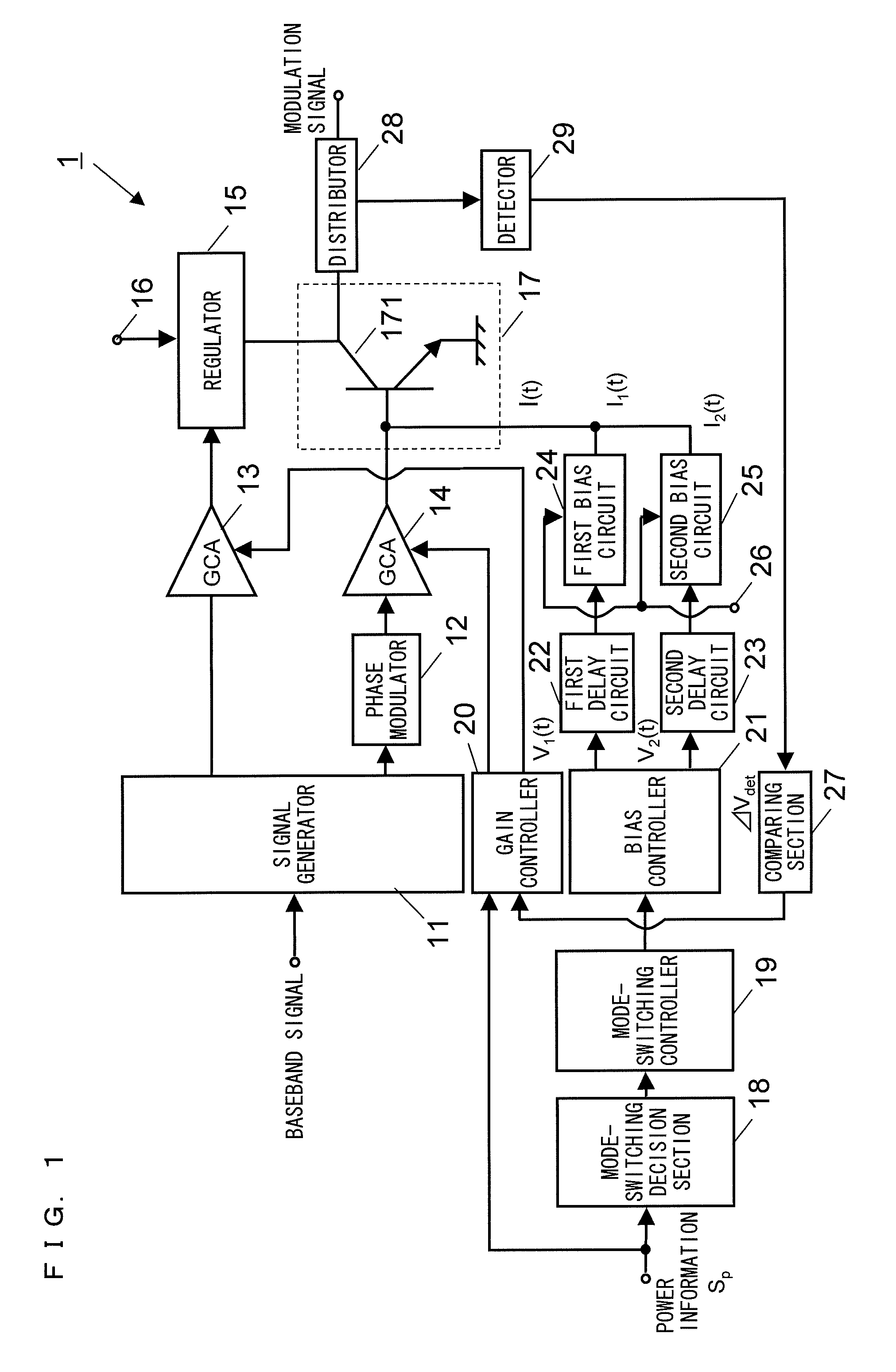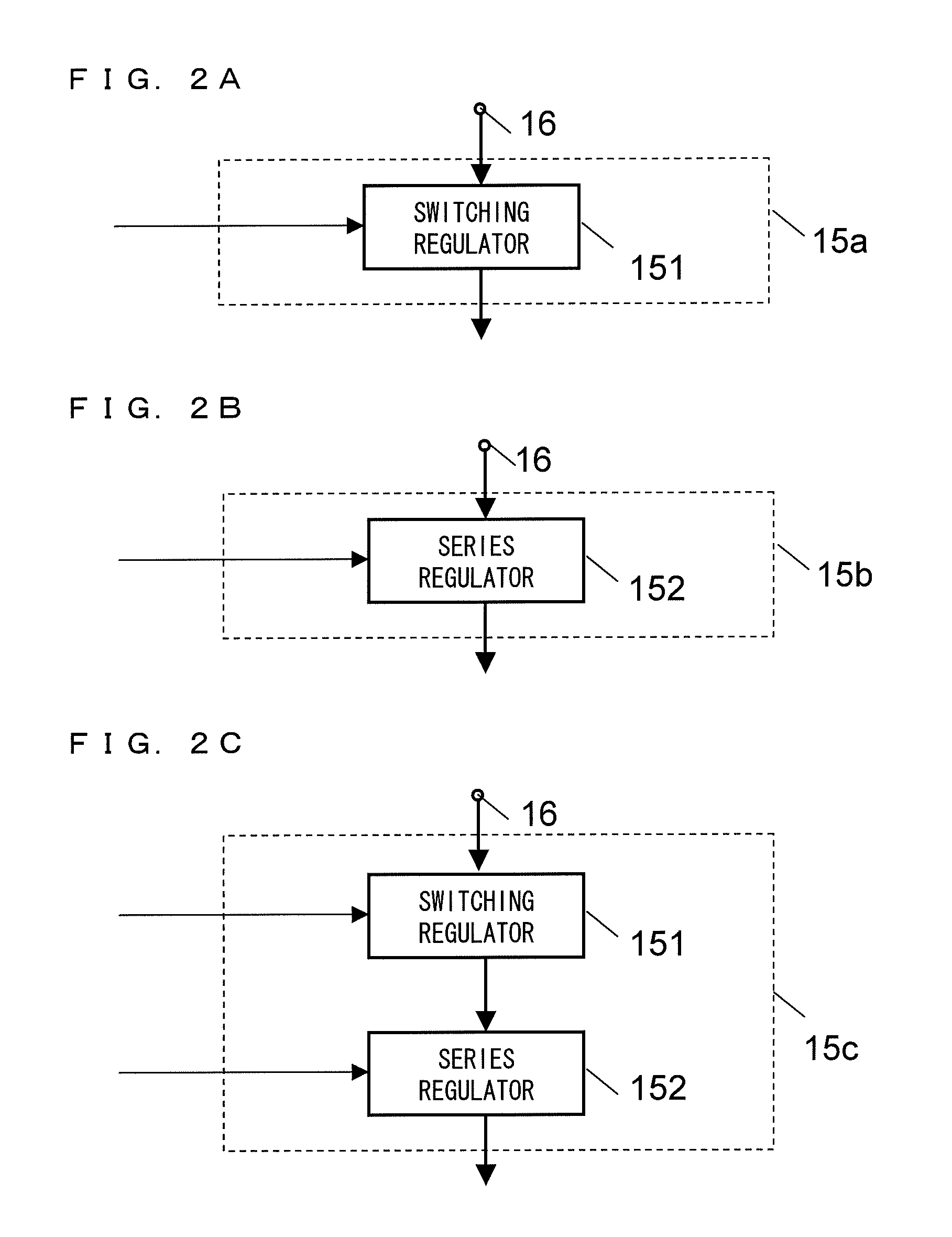Transmission circuit for bias control of power amplifier
a power amplifier and bias control technology, applied in pulse technique, phase-modulated carrier system, baseband system details, etc., can solve the problem that the power amplifier b>504/b> cannot be prevented from entering a non-bias state, and achieve the effect of preventing the output signal, conducting the switching of operation mode, and high efficiency
- Summary
- Abstract
- Description
- Claims
- Application Information
AI Technical Summary
Benefits of technology
Problems solved by technology
Method used
Image
Examples
first embodiment
[0042]FIG. 1 is a block diagram showing one configuration example of a transmission circuit 1 according to a first embodiment of the present invention. The transmission circuit 1 in FIG. 1 includes: a signal generator 11; a phase modulator 12; a first variable gain amplifier (GCA) 13; a second variable gain amplifier (GCA) 14; a regulator 15; a power supply terminal 16; a power amplifier 17; a mode-switching decision section 18; a mode-switching controller 19; a gain controller 20; a bias controller 21; a first delay circuit 22; a second delay circuit 23; a first bias circuit 24; a second bias circuit 25; a power supply terminal 26; a comparing section 27; a distributor 28; and a detector 29. The power amplifier 17 includes a transistor for amplification 171.
[0043]In the transmission circuit 1, the signal generator 11 conducts a predefined signal processing on a baseband signal, and generates an amplitude signal and a phase signal. The amplitude signal is inputted into the regulator...
second embodiment
[0077]FIG. 5 is a block diagram showing one configuration example of a transmission circuit 2 according to a second embodiment of the present invention. The transmission circuit 2 in FIG. 5 includes: the signal generator 11; the phase modulator 12; the first variable gain amplifier (GCA) 13; the second variable gain amplifier (GCA) 14; the regulator 15; the power supply terminal 16; the power amplifier 17; a mode-switching decision section 58; a mode-switching controller 59; a gain controller 60; the bias controller 21; the first delay circuit 22; the second delay circuit 23; the first bias circuit 24; the second bias circuit 25; the power supply terminal 26; a comparing section 67; the distributor 28; and a detector 69. The power amplifier 17 includes the transistor for amplification 171.
[0078]When compared to the transmission circuit 1 according to the first embodiment, the characteristic of the transmission circuit 2 according to the second embodiment is conducting the operation ...
third embodiment
[0097]FIG. 9 is a block diagram showing one configuration example of a communication device according to a third embodiment of the present invention. The communication device 200 according to the third embodiment in FIG. 9 includes: a transmission circuit 210; a reception circuit 220; an antenna duplexer 230; and an antenna 240. The transmission circuit 210 is the transmission circuit described above in either the first or the second embodiment. The antenna duplexer 230 transmits a transmission signal outputted from the transmission circuit 210 to the antenna 240, and prevents the transmission signal from leaking into the reception circuit 220. Furthermore, the antenna duplexer 230 transmits a reception signal inputted from the antenna 240 to the reception circuit 220, and prevents the reception signal from leaking into the transmission circuit 210. As a result, the transmission signal is outputted from the transmission circuit 210 and released out into open space from the antenna 2...
PUM
 Login to View More
Login to View More Abstract
Description
Claims
Application Information
 Login to View More
Login to View More - R&D
- Intellectual Property
- Life Sciences
- Materials
- Tech Scout
- Unparalleled Data Quality
- Higher Quality Content
- 60% Fewer Hallucinations
Browse by: Latest US Patents, China's latest patents, Technical Efficacy Thesaurus, Application Domain, Technology Topic, Popular Technical Reports.
© 2025 PatSnap. All rights reserved.Legal|Privacy policy|Modern Slavery Act Transparency Statement|Sitemap|About US| Contact US: help@patsnap.com



